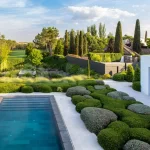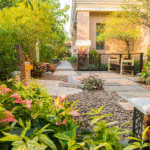Contemporary gardens have become increasingly popular in recent years due to their sleek and minimalist design, as well as their focus on incorporating sustainable and environmentally friendly practices. These gardens often feature clean lines, geometric shapes, and an overall sense of simplicity that creates a sense of order and tranquility.
One of the key elements of contemporary gardens is the use of sustainable materials and practices. This can include using recycled materials for hardscaping, such as reclaimed wood or stone, as well as incorporating native plants that require less water and maintenance. By taking a more eco-friendly approach, contemporary gardens not only look great but also help to reduce their impact on the environment.
In terms of design, contemporary gardens often feature a strong emphasis on outdoor living spaces. This can include outdoor kitchens, dining areas, and lounge spaces that are seamlessly integrated into the overall design of the garden. By blurring the lines between indoor and outdoor spaces, contemporary gardens provide a welcoming and inviting atmosphere for relaxation and entertainment.
Another key feature of contemporary gardens is their use of technology. This can include automated irrigation systems, LED lighting, and smart gardening tools that help to make maintenance easier and more efficient. By embracing technology, contemporary gardens are able to achieve a high level of sophistication and functionality that sets them apart from traditional gardens.
In terms of plant selection, contemporary gardens often favor a restrained color palette and a focus on texture and form. This can include using a limited range of plants in a monochromatic scheme, as well as incorporating sculptural plants with interesting shapes and textures. By carefully selecting plants that complement the overall design aesthetic, contemporary gardens are able to create a cohesive and harmonious look.
Overall, contemporary gardens offer a fresh and modern approach to garden design that is both stylish and practical. By incorporating sustainable materials and practices, embracing technology, and carefully selecting plants that enhance the overall design, contemporary gardens are able to create beautiful outdoor spaces that are both aesthetically pleasing and environmentally friendly.
















